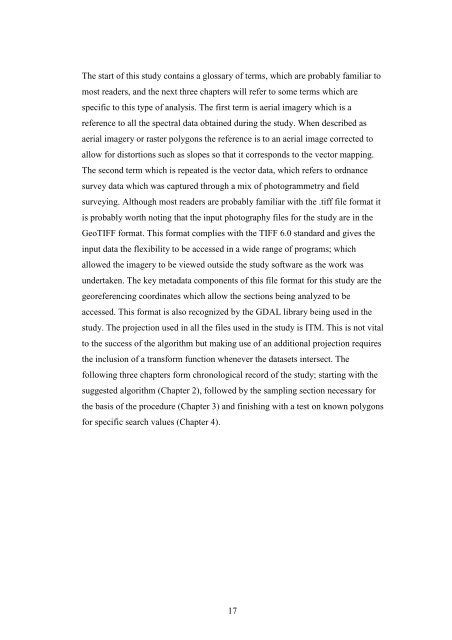You also want an ePaper? Increase the reach of your titles
YUMPU automatically turns print PDFs into web optimized ePapers that Google loves.
The start of this study contains a glossary of terms, which are probably familiar to<br />
most readers, and the next three chapters will refer to some terms which are<br />
specific to this type of analysis. The first term is aerial imagery which is a<br />
reference to all the spectral data obtained during the study. When described as<br />
aerial imagery or raster polygons the reference is to an aerial image corrected to<br />
allow for distortions such as slopes so that it corresponds to the vector mapping.<br />
The second term which is repeated is the vector data, which refers to ordnance<br />
survey data which was captured through a mix of photogrammetry and field<br />
surveying. Although most readers are probably familiar with the .tiff file format it<br />
is probably worth noting that the input photography files for the study are in the<br />
GeoTIFF format. This format complies with the TIFF 6.0 standard and gives the<br />
input data the flexibility to be accessed in a wide range of programs; which<br />
allowed the imagery to be viewed outside the study software as the work was<br />
undertaken. The key metadata components of this file format for this study are the<br />
georeferencing coordinates which allow the sections being analyzed to be<br />
accessed. This format is also recognized by the GDAL library being used in the<br />
study. The projection used in all the files used in the study is ITM. This is not vital<br />
to the success of the algorithm but making use of an additional projection requires<br />
the inclusion of a transform function whenever the datasets intersect. The<br />
following three chapters form chronological record of the study; starting with the<br />
suggested algorithm (Chapter 2), followed by the sampling section necessary for<br />
the basis of the procedure (Chapter 3) and finishing with a test on known polygons<br />
for specific search values (Chapter 4).<br />
17
















